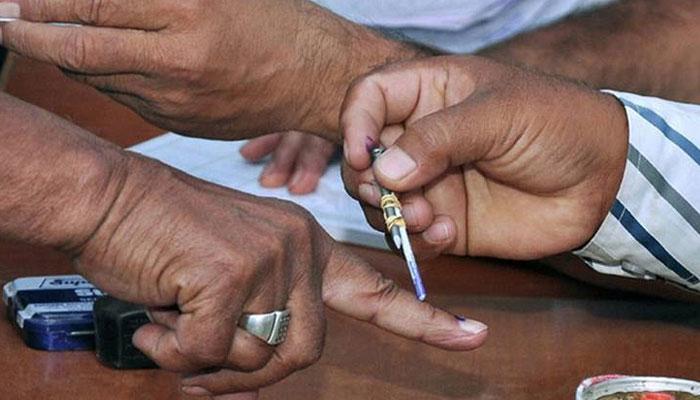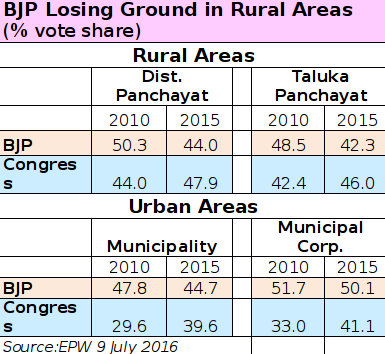BJP Can Be Beaten In Gujarat

It is customary to believe that Modi led BJP is unbeatable in Gujarat. But there is a strong element of hype in this belief. Electoral trends of vote shares in the past several elections in Gujarat show that the BJP’s stranglehold is cracking up, and it is not at all certain that they will win the forthcoming Assembly elections.
The state has seen six elections since 2007: two each of local bodies’ elections (in 2010 and 2015), Assembly (2007 and 2012), Lok sabha (2009 and 2014). Till 2014 the gap between BJP and its only challenger in Gujarat, Congress, was seemingly widening. In the 2012 Assembly elections BJP got nearly 48% vote share as opposed to the Congress’ 39%. In the 2014 Lok Sabha elections, BJP won all 26 Lok Sabha seats in the state capturing a phenomenal 59% of vote share. This is what created the image of invincibility.
But in the last elections held in the state – the local bodies’ elections of 2015 – the whole equation started changing. For the first time in over a decade, ruling BJP lost the rural local bodies to Congress, while in urban local bodies the BJP still won but with a much reduced gap. The Congress won 24 of the 31 district panchayats and 134 of the 230 taluka panchayats. In 2010 it had held only 6 district panchayats and 67 taluka panchayats.

In terms of vote share, Congress increased its vote share from 44% in 2010 to nearly 48% in 2015 in district panchayats; and from 42.4% to 46% in taluka panchayats. On the other hand, BJP’s vote share declined from over 50% to 44% in district panchayats and from 48.5% to 42.3% in taluka panchayats.
Clearly, rural areas, in the throes of a deep agrarian crisis, had turned against the BJP. The vehicle of this change was the patidar agitation led by Hardik Patel, which started in early 2015, before the local bodies’ elections were held in August of that year. The Patel community had been supporting BJP solidly for years but it became hostile to the rulers after the police crackdown on their agitation for job reservation in which 14 lives of Patel youth were lost.
In local bodies of urban areas the BJP held its ground in the 2015 elections although their vote share dipped. It retained all 56 municipalities and all 6 municipal corporations although its vote share reduced from 48% to 45% in the former and from 52% to 50% in the latter.
The rural-urban divide in the BJP’s vote base had thus crystallized in the 2015 elections. And, now after two years there is no reason to believe that there has been a reconsolidation behind BJP. In fact other fissures have emerged that may further damage BJP’s position and its support base has been further eroded. Other Backward Classes and dalits, have started fighting for their rights in opposition to BJP. The dalits have raised their voice at continued atrocities against them, sparked off by the Una incident of stripping and public beating of dalit youth for going about their traditional occupation of flaying and disposing off cattle carcasses. There are rumblings of dissent in tribal areas against continued neglect by the BJP govt.
In short, the whole social base built by BJP after the communal holocaust of 2002, based on an imposed Hindutva identity that subsumed various castes and social identities has been torn asunder by the much deeper agrarian economic crisis. Food grain and oilseed production is stagnating for the past nearly a decade, and cotton output is stagnating for the past 6-7 years with some ups and downs, as per RBI data on output. Farmers’ debt is increasing while incomes are stagnating. All this is finding expression in various caste based movements, but also in farmers’ agitations on their issues. Unemployment is increasing generally as industrial production has plateau-ed off.
So, the BJP may well be on the brink of a shock in the coming Assembly elections.
Get the latest reports & analysis with people's perspective on Protests, movements & deep analytical videos, discussions of the current affairs in your Telegram app. Subscribe to NewsClick's Telegram channel & get Real-Time updates on stories, as they get published on our website.





















